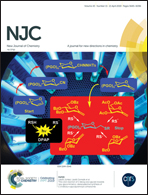A fluorescent sensor for thymine based on bis-BODIPY containing butanediamido bridges†
Abstract
The sensor for thymine detection has a great significance in the analysis of deoxyribonucleic acid in living organisms. In this work, a series of bis-BODIPY derivatives, namely, 3a–3c with diamido bridges were designed and prepared in yields of 74–77% through a simple procedure. The sensing abilities of compounds 3a–3c for adenine, guanine, cytosine, thymine, glucose, urea and haemoglobin were examined by UV-vis and fluorescence spectra. Sample 3b was demonstrated to be a good selective sensor for thymine among all the other tested species. The detection limit of sample 3b was as low as 1.53 × 10−6 M for thymine. The competitive experiments suggested that the selective sensor for thymine was influenced slightly by the other species. The proposed sensing mechanism was confirmed by FT-IR, 1H NMR and MS spectra. Sample 3b exhibited good bioimaging performance with bright green fluorescence in living cell imaging. The significant fluorescence quenching phenomenon after the addition of thymine implied the sensing ability of sample 3b for thymine in living cells.



 Please wait while we load your content...
Please wait while we load your content...